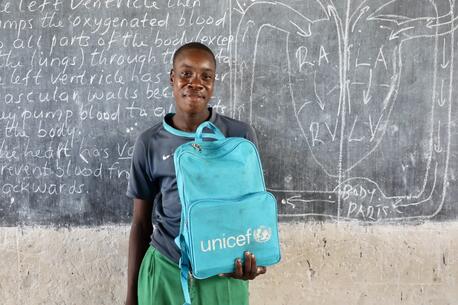
Five Ways UNICEF Is Taking Action Against Climate Change
UNICEF is working with partners around the world to identify and implement affordable, scalable solutions to curb the impacts of climate change.
UNICEF and partners are working tirelessly all over the world to save and protect children.
All children need clean air to breathe, clean water to drink and a safe and sustainable environment. But the devastating effects of climate change and environmental degradation are jeopardizing the futures of children around the world. Global emissions are reaching record levels. Droughts, floods, cyclones and other extreme weather events linked to climate change are endangering communities, creating food insecurity and threatening water supplies. According to the Global Commission on Adaptation, climate-change related impacts could push more than 100 million people in developing countries below the poverty line by 2030.
UNICEF is working with partners around the world to identify and implement affordable, scalable solutions that will help curb the impact of climate change on the lives of children, and enable us to leapfrog to cleaner, more resilient economies. Some examples:
Building schools with recycled plastic bricks in Côte d'Ivoire

© UNICEF/UN0288511/Frank Dejongh
Education is compulsory in Côte d'Ivoire for children between the ages of 6 and 16, but overcrowding has kept more than 2 million kids out of school. Meanwhile, millions of tons of plastic garbage end up in landfills and oceans every year. UNICEF teamed up with Conceptos Plasticos, a Colombian company, to create an ingenious solution that addresses both problems: Build a factory that transforms plastic waste into durable, low-cost bricks, then slot the bricks together like Legos to construct schools. Above, UNICEF staffer Stéphane Gbonikan and a young student celebrate a new classroom made of recycled plastic bricks in Sakassou, a village in central Côte d'Ivoire.
Improving indoor air quality in Mongolia

© UNICEF/UN0255494/Bayarsaikhan
Home to half of Mongolia's population of 3 million, Ulaanbaatar has the most toxic air in the world during the freezing cold winter months. Sixty percent of the city's inhabitants live in traditional "gers" — flexible, lightweight, one-room dwellings heated by coal-burning stoves that pollute the air and damage children's lungs. To reduce coal consumption and improve indoor air quality for families living in gers, UNICEF Mongolia, UNICEF's Office of Innovation and local implementing partner GerHub are working to design an environmentally friendly "21st century ger."
Bringing clean, reliable sustainable energy to Burundi

© UNICEF/UN0327346/Le Du
Most of rural Burundi is off the electricity grid, so households typically rely on wood, batteries and kerosene for power. Through Project Lumière, UNICEF helps community groups procure solar charging stations to power headlamps. This clean, reliable, sustainable energy source is more affordable and better for the environment. Above, 9-year-old Nadia wears the solar lamp her family purchased from their local Project Lumière collective in Nonge, in Burundi's southern Bakamba province. Nadia uses the headlamp to study at night, instead of reading by candlelight, and says she is no longer afraid to venture outside to go to the bathroom after dark.
Protecting safe water sources from saltwater intrusion in Bangladesh

© UNICEF/UN0286426/Lawson Tancred
Climate change-related extreme weather events and longer term phenomena such as sea level rise and saltwater intrusion are deepening the environmental threat to already vulnerable families in Bangladesh. UNICEF is working with the government to provide sustained safe water access to millions by protecting their drinking water against the intrusion of salt water from the sea using a system known as Managed Aquifer Recharge. The system is working in around 75 communities and is ready to be taken to scale. Above, 11-year-old Maroof has vivid memories of the terrible flood that swept through his village, Nizampur, in Patuakhali District on the Bay of Bengal in 2017, displacing his family and killing his 8-year-old friend Iqbal.
Installing solar-powered water pumps in South Sudan — and 34 other countries

© UNICEF/UN0221045/Rich
UNICEF currently uses solar-powered water pumps in 35 countries, with plans to expand. Solar-powered water systems are a green technology with minimal environmental impact. They're easy for communities to maintain, rarely break down and don't require expensive fuel supply. Above, in South Sudan, the world's least electrified country, 9-year-old Alex brings a jerry can full of safe water to his family's home in Yambio during his lunch break. The system pumps treated water from a borehole to different communities, schools and the local health center.
The only organization specifically named in the Convention on the Rights of the Child, UNICEF works with governments and private sector partners around the world to translate the principles of child rights into real results for children everywhere.
Top photo: A child wades through flood water on her way to school in the Kurigram district of northern Bangladesh during monsoon season. © UNICEF/UN0286416/Akash
HOW TO HELP
There are many ways to make a difference
War, famine, poverty, natural disasters — threats to the world's children keep coming. But UNICEF won't stop working to keep children healthy and safe.
UNICEF works in over 190 countries and territories — more places than any other children's organization. UNICEF has the world's largest humanitarian warehouse and, when disaster strikes, can get supplies almost anywhere within 72 hours. Constantly innovating, always advocating for a better world for children, UNICEF works to ensure that every child can grow up healthy, educated, protected and respected.
Would you like to help give all children the opportunity to reach their full potential? There are many ways to get involved.



